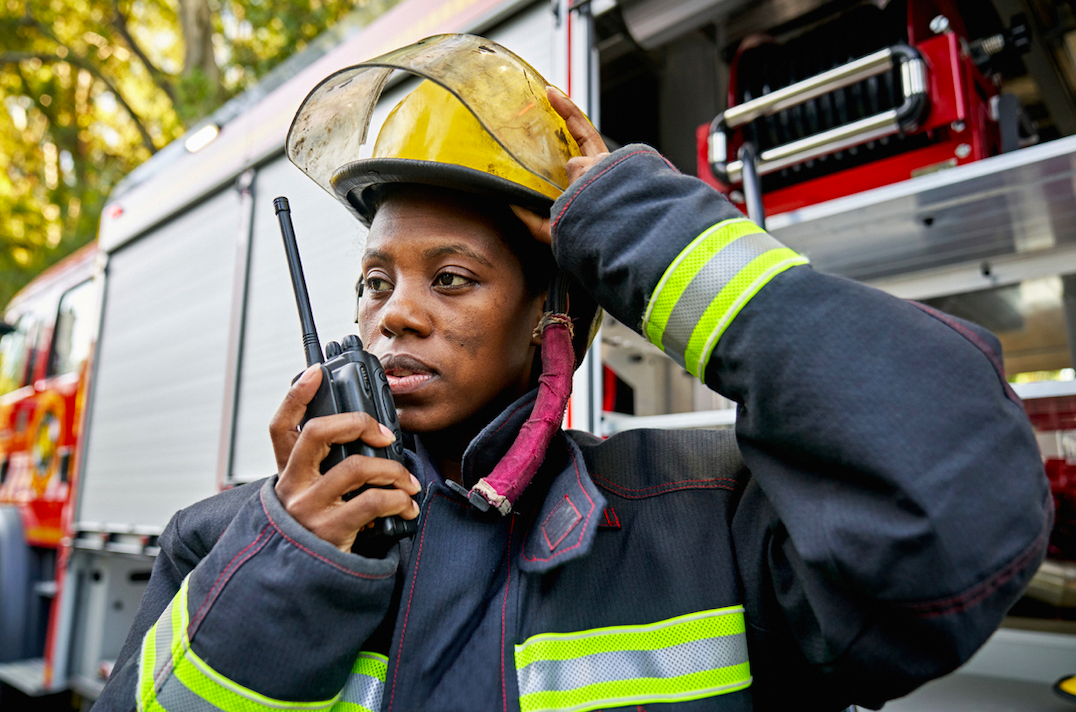Sometime in the mid-aughts, Cici Bracaglia found herself at an FDNY recruiting event at a lesbian bar in New York City. Although Bracaglia enjoyed helping people and keeping active, she hadn’t considered firefighting as a career before. “I had thought it was still for men. I didn’t think I could reach the strength or cardiovascular stamina that it required,” she tells GO.
But seeing a queer FDNY lieutenant behind the table at the event put things in perspective. “She looked a lot like me,” Bracaglia says. “And that’s all it took.”
In 2005, around the time that Bracaglia met that lieutenant, less than 2.5% of firefighters were women. Today, that number has only grown to about 8%. Out of around 1 million firefighters nationwide, only 5% of them are LGBTQ+, a number which can only be considered an estimate, as many people might not be out at work.
“It can be daunting to enter a space that isn’t really considered yours,” says Charlie Donohue, a queer non-binary firefighter in Alexandria, Virginia. This past April, Corey Boykins, a gay FDNY firefighter, sued the organization on the grounds of discrimination, recounting stories where he had been told to sleep with women, which might help “cure” his homosexuality. Since the pandemic, there’s been three LGBTQ+ discrimination lawsuits against the San Francisco Fire Department. Another gay firefighter sued the Chicago Fire Department for workplace discrimination in 2020.
But Bracaglia, who’s been a firefighter with the FDNY since 2013, says “Are you going to find homophobia and transphobia? You’re going to find it everywhere, but that’s not the norm here. It’s a very welcoming community. I also think the fire department has done a really good job at being aware of it, while chipping away at those lines of thinking.” She says that the lawsuits against certain fire stations don’t represent the vast majority of inclusive departments across the country, and that these cases don’t mean that work isn’t being done to dismantle the conditions that allowed them to happen in the first place.
Many of these departments have LGBTQ+ liaison and community-based groups. In NYC, the FireFLAG/EMS, an organization for queer and trans firefighters, EMTs, and paramedics in the FDNY, just celebrated their 30th anniversary. The group is responsible for community outreach programs and liaison activities, in which they host conversations with allies and other firefighters, EMTs, and paramedics to dismantle discrimination in the workplace and amongst the civilians they serve. Beyond that, their social media platforms show smiling faces at game nights, barbecues, beach days, and other events, where members are able to find camaraderie in one another, both in and outside of their stations. This feeling of comfort has stuck with J.L., an EMT with the FDNY and member of FireFlag/EMS who wished to remain anonymous. “We don’t work directly, but they’re automatically my family because I can be myself all the way with them,” she says.
Down in Virginia, they have the Alexandria LGBTQ+ Task Force, where Donohue is a liaison for the Fire Department. The group spearheads training events and conversations around equity and inclusion, so that all members of a firehouse are respected by their peers. Much of the task force’s work is also centered around “creating safety” for LGBTQ+ community members, who are more likely to be under-reported victims of domestic violence, as well as hate crimes, sexual abuse, and other types of physical and emotional assault. For the LGBTQ+ firefighters, paramedics, and EMTs, this knowledge, mixed with their identity, gives them an advantage of being a familiar or calming face to LGBTQ+ civilians.
Some of the most impactful work experience Charlie has comes from comforting other queer people on some of their worst days. “There was one night we got a call, and it was an elderly gay couple. One of them needed to go to the hospital, and I sat with his husband,” Charlie remembers. After a while, another task pulled them away, but Charlie recounts hearing the husband ask for them to come back, finding more comfort in them than their heterosexual counterparts.
“More people are able to identify with me, and that’s a layer of safety,” says J.L. “When we get calls from the LGBTQ+ community, they feel comfortable with me. But then I have people who don’t like me since I’m female or gay. I don’t take it personally. That’s on them, and you’ll deal with that everywhere.”
In emergency calls, she’s had people hesitant to have her carry them down the stairs out of a fear driven by a misconception about her physical abilities. She’s never dropped anyone, she says. And once they’re in an ambulance safely, their mind shifts. This need to prove one’s self creates uneven ground, but without breaking that ground, the prejudice remains.
Donohue’s narrative is a similar one. Their experience as a gay person has been warm and welcoming, but they’re no stranger to pushback and confusion as far as their being non-binary goes. They’re grateful for the fact that, mostly, firefighters refer to each other by their last names, but they’re also grateful for their peers’ desire to learn. “I had a whole conversation with my captain about what it means to be trans,” they say. “It opened up his world. I feel like he left that conversion a better person, which is the best part of my job. Aside from saving lives.”


What Do You Think?